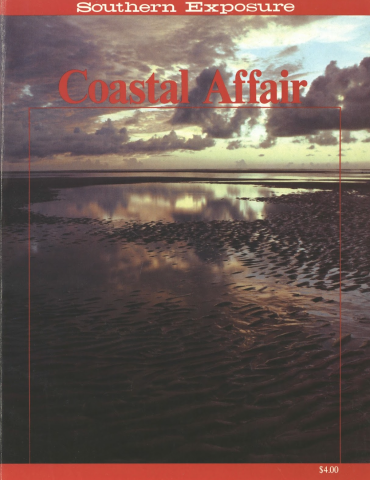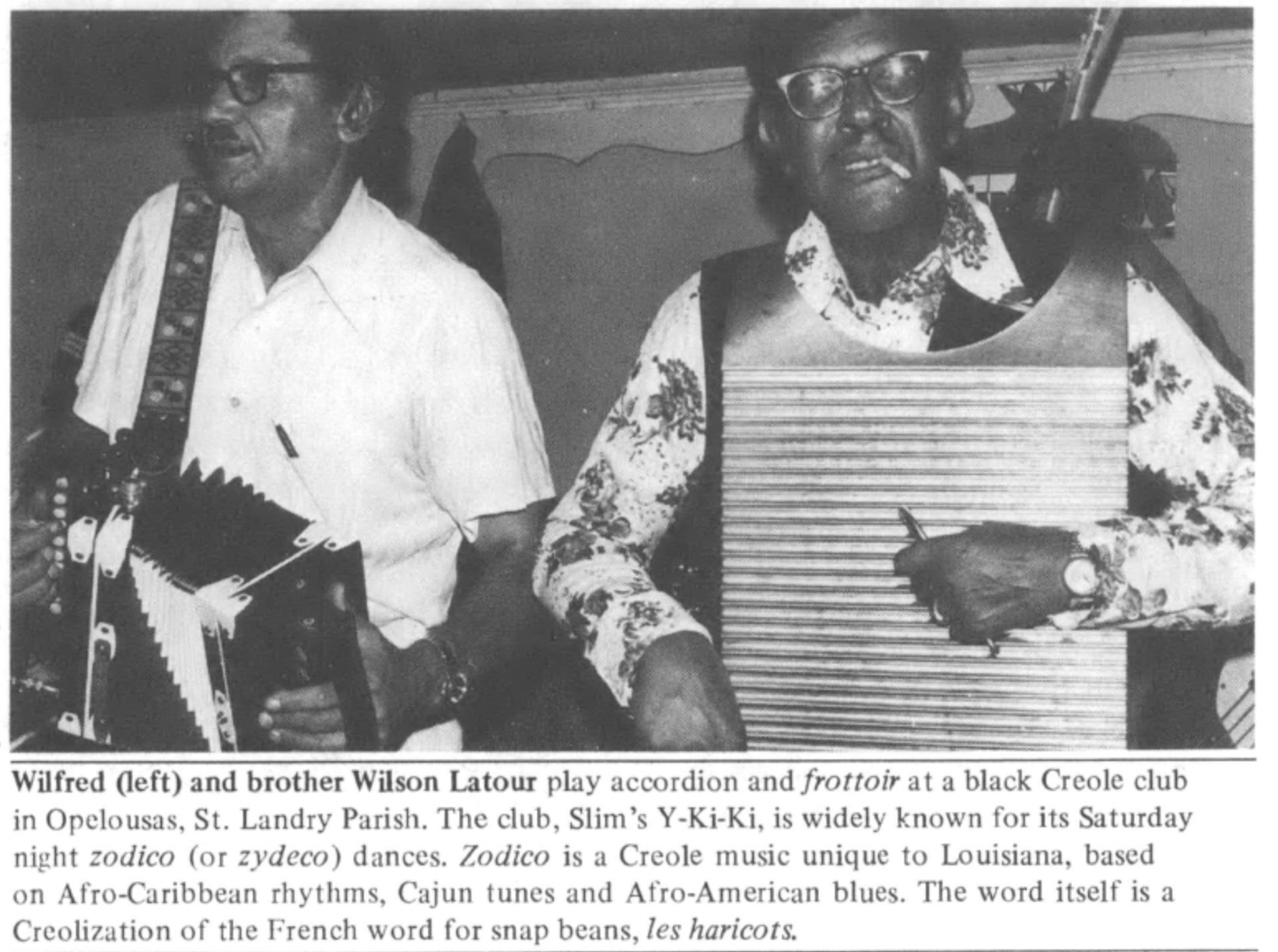
This article originally appeared in Southern Exposure Vol. 10 No. 3, "Coastal Affair." Find more from that issue here.
The Louisiana Gulf Coast may have the greatest diversity and persistence of folk traditions of any area of the United States. In addition to the well-known cultural uniqueness of New Orleans, the many rural populations of south or “French” Louisiana until recently remained economically and socially isolated in a landscape laced with bayous, swamps, coastal marsh prairies and fertile levee lands. It is in this increasingly industrialized rural region that cultural groups such as Cajuns, Creoles, Islenos, Yugoslavs and Houma Indians are struggling to maintain their distinctiveness today. This sub-region, which also extends in part to the Mississippi coast, owes as much or more culturally to the Afro-Latin Caribbean as to the Anglo-dominated Upland and Deep South. As local anthropologist C. Paige Gutierrez has said, this central area of the Gulf Coast is “south of the South.”
There are several ways in which south Louisiana can be understood as an extension of the Caribbean culture area, beginning with the parallel tropical environment and colonial development of the areas. Louisiana was controlled by France and Spain, two of the great Caribbean colonial powers, during the eighteenth century. Especially in terms of French colonialism, it was a small pearl on a sugar empire necklace that was dominated by St. Domingue (Haiti). Although Louisiana never produced sugar for European tables in quantities comparable to Haiti or Martinique, it did share the planter/slave social order with the French West Indies. The plantation sphere brought together the aesthetics and lifestyle of a small European cultured elite and the West African folk traditions of the masses, giving rise to the gens libres de couleur (free people of color) in both the French West Indies and Louisiana. It is generally presumed that Catholicism and a sometimes more liberal view of the human qualities of the slave/planter offspring allowed this class to arise and persist.
Another way that south Louisiana is culturally related to the Caribbean is via the actual movement of many of the area’s diverse peoples from the West Indies to the mainland and back. At the American takeover in 1803, some French planters left Louisiana for Martinique and elsewhere. Prior to that in 1777, many Spanish Canary Islanders or Islenos, some of whom had previously settled in Cuba, had come to Louisiana during the Spanish colonial period in an attempt to Hispanicize Louisiana’s culturally French society. To the present the Islenos, as fishers and trappers in St. Bernard Parish below New Orleans, maintain folk food traditions as in the dish caldo and sing Spanish ballads called decimas. Further, Louisiana has been, and continues to be, a recipient of Spanish circum-Caribbean populations from Cuba, Nicaragua and Honduras, among other countries.
The most significant historical Caribbean influx to Louisiana was that of the French refugees from St. Domingue during and after the Haitian revolution. The arrival of 10,000 planters, gens libres de couleur and slaves after 1804 doubled the New Orleans population, assured the city a distinct West Indian flavor and gave new life to French Creole culture at a time of initial American control. It is this flood of people that gave rise to some of south Louisiana’s unique folklife traditions. These traditions include Afro- and medieval French-influenced folk Catholicism (voodoo, traiteurs, home altars and yard shrines), foodways (gumbo, jambalaya and red beans and rice), music (spasm jazz, street chants and zodico), Afro-Caribbean-derived dances (calinda, bamboula and now “second lining”), architecture (New Orleans shotgun houses and rural Creole cottages), and the continuing emphasis on festivals and street parades (Mardi Gras and jazz funerals).
In addition to similar plantation cultures and the actual back and forth migration, there was and is a parallel cultural diversity between island and Louisiana societies in general. The cultural base of both the Caribbean and south Louisiana is mainly of African and Mediterranean origins. During the colonial period, both areas also received French and Spanish peasant fishing and farming groups. Later, Syrian, Jewish and Lebanese traders and Italians came as post-slavery laborers. Further, both areas were settled with intermingling and strife between the colonial population and Native American groups such as the Ciboney, Arawak and Carib in the Caribbean and the Houma, Choctaw, Attakapas, Chitimacha and Bayou Goula in Louisiana.
Certainly the single best-known and dominant cultural group in rural south Louisiana has been the Acadians. They, with a few exceptions, did not come from the Caribbean. The Acadians or Cajuns arrived in Louisiana over a 30-year period after 1765 as exiles from what is now Nova Scotia. Prior to settling in Louisiana, they had been dispersed throughout the American colonies, returned to France (from whence they had come in the early seventeenth century), been imprisoned in England or migrated to the French Caribbean colonies. When the Acadians arrived in New Orleans, the colony had been ceded to Spain. The former farmers and fisherfolk from the cold north became petits habitants on levee crest farms along the rivers and bayous of sweltering Louisiana, as well as trappers and fishers in the back swamps and lower coastal marshes.
The 22 parishes of southwest Louisiana are usually referred to as “Acadiana,” or “Cajun country.” However, not all the people who reside there are Cajuns; not all Cajuns speak French; and not all people of French descent are Cajuns. In addition to the descendants of European Creoles, Creoles of Color, French slaves and settlers directly from the Old World, many Houma and Chitimacha Indians speak French, but none of these groups are usually considered Cajuns. It is the peasant-derived Cajun culture, rather than the former Creole colonial elites, that has survived most identifiably to the present. The Cajuns have, over time, managed to assimilate and acculturate the Anglos, Germans, Italians and Spanish with whom they came into contact, not to mention the French planter aristocracy and black populations.
The Cajuns themselves largely resisted acculturation to mainstream American ways until the last 50 years. In this period, schools began to promote the English language and literacy at the expense of oral French; the arrival of hard surface roads over soft, wet land allowed cars to replace boats and carriages; World War II forced many Cajun men to leave their rural life for the first time; and the powerful forces of English language media and the Anglo-dominated oil industry expanded the influence of American culture. However, in the face of changing linguistic and social customs, Cajun music continued to be heard. With its roots in the seventeenth-century French dance hall, filtered through the impact of jazz, blues and hillbilly music, Cajun music along with food and- festivals often serves to symbolize the romantic cultural revival that French Louisiana is now undergoing.
Alongside and mingling with the Cajuns, the Creole culture of south Louisiana is significant. The term “Creole” has great semantic elasticity and often varies in meaning, depending upon who is talking to whom, about what, or whether it is used as a noun or an adjective. Derived from the Portuguese criuolo (meaning “native to a region”), “Creole” originally described the descendants of the European colonial population in the West Indies, Latin America, Louisiana and later the “Creoles of Color.” With Anglo-American intrusion into Louisiana, many slaves, as well as free people who did not consider themselves black, looked more to their European heritage than an African heritage to separate themselves from les americains, both black and white. Thus, Creole, a term once associated with the “pure” descendants of the European colonists, came also to be linked to people of diverse ancestry and culture: black, Indian, French, Spanish.
In rural Louisiana many of the Creoles of Color (some of whom held their own slaves) and French slaves mingled with the arriving Cajuns. As a result, some black and lighter people known as mulatres are more Cajun than Old World French or Afro-American in their cultural orientation. However, among the rural Afro-French of Louisiana, some retain strong ties to Caribbean culture in speaking “Creole” — a language that can be briefly described as French words within a New World Africanized system of grammar and sound (parallel to the English-based Gullah of the Georgia Sea Islands) as well as in “Afro-Caribbean” dress, foodways and musical style. Zodico music, for example, reflects a middle ground between Afro-Caribbean rhythm patterns with tonal and repertoire influence from Afro-American music and the melodic sources of Cajun music.
The diverse foundation of south Louisiana noted previously was enhanced by the arrival of Yugoslavs, among other central and eastern European groups, before and after the start of the twentieth century. Asian input from China and the Philippines has also added to the cultural mix with the newest group being the Vietnamese, many of whom speak French and have pursued fishing as a trade. All these groups, past and present, have given rise to what has been described by New Orleans folklorist George Reinecke as a “Creole society”: that is, a society which has emerged as a multi-cultural whole without totally losing the uniqueness of its separate parts. As such, south Louisiana is the only area in the coastal South and the United States where a predominant Afro-Latin-Anglo-Asian cultural diversity is the source of a unified regional identity.
Tags
Nicholas R. Spitzer
Nicholas Spitzer, is a folklorist working with the state of Louisiana, with a special interest in south Louisiana’s ethnic diversity and black Creole music and festivals. (1982)

